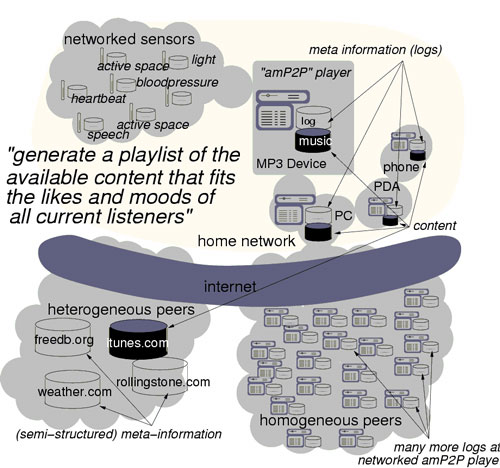|
|||
|
 |
| Scenario: "generate a playlist of the available content that fits the likes and moods of all current listeners". |
The premise of the AmbientDB project is that this middleware role of integrating context-awareness and access to distributed multimedia retrieval servers could be handled by P2P database technology. Such technology allows devices to self-organise in ad-hoc overlay networks, without the need for central coordination. The principal functionalities it aims to provide are:
- ad-hoc integration of possible diverse information sources into a global schema. This concerns both integration of data access as well as services (queries) supported on this data by the participating peers
- facilities for ad-hoc query execution over this integrated global schema. By using high-level query languages, applications can concentrate on the issue of 'what' to ask, while the database technology concentrates on 'how' to execute such requests in an optimal manner
- a framework for expressing diverse replication, and update/ synchronisation strategies.
One important research question in AmbientDB is which data model and query formulation framework is sufficient to support non-trivial semantic multimedia retrieval queries. The fact that AmbientDB target devices may be mobile and are frequently disconnected, also opens up questions as to alternative update propagation frameworks that can, for example, aim at convergence rather than pure transactional serialisation. Additionally, we look at formalisms that allow expression of application-specific (loose) consistency constraints, replication mechanisms and conflict resolution strategies, using tools such as gossip protocols. Finally, query execution in an ad-hoc network of highly heterogeneous devices poses a number of resource optimisation challenges, which form the current focus of our research.
The AmbientDB project started in the summer of 2002 at the INS1 group of the Information Systems cluster at CWI. This group researches novel database architectures and their integration into advanced application areas, in particular semantic multimedia retrieval. We focus on the area of multimedia in advanced consumer environments, and cooperate in this area with Philips Natlab, which is looking at P2P database techniques to provide integrated data managements for its future generation of networked consumer electronics. This cooperation is part of the MultimediaN national Dutch knowledge infrastructure project. In particular, Twente University will use AmbientDB as its vehicle for a semantic context-based query tool in this project. The MultimediaN project is expected to start in the winter of 2003 and run through to 2007.
Links:
http://www.cwi.nl/~boncz
http://www.cwi.nl/ins1
http://db.cwi.nl/rapporten/abstract.php?abstractnr=1355
Please contact:
Peter Boncz, CWI
Tel: +31 20 592 4309
E-mail: boncz@cwi.nl


